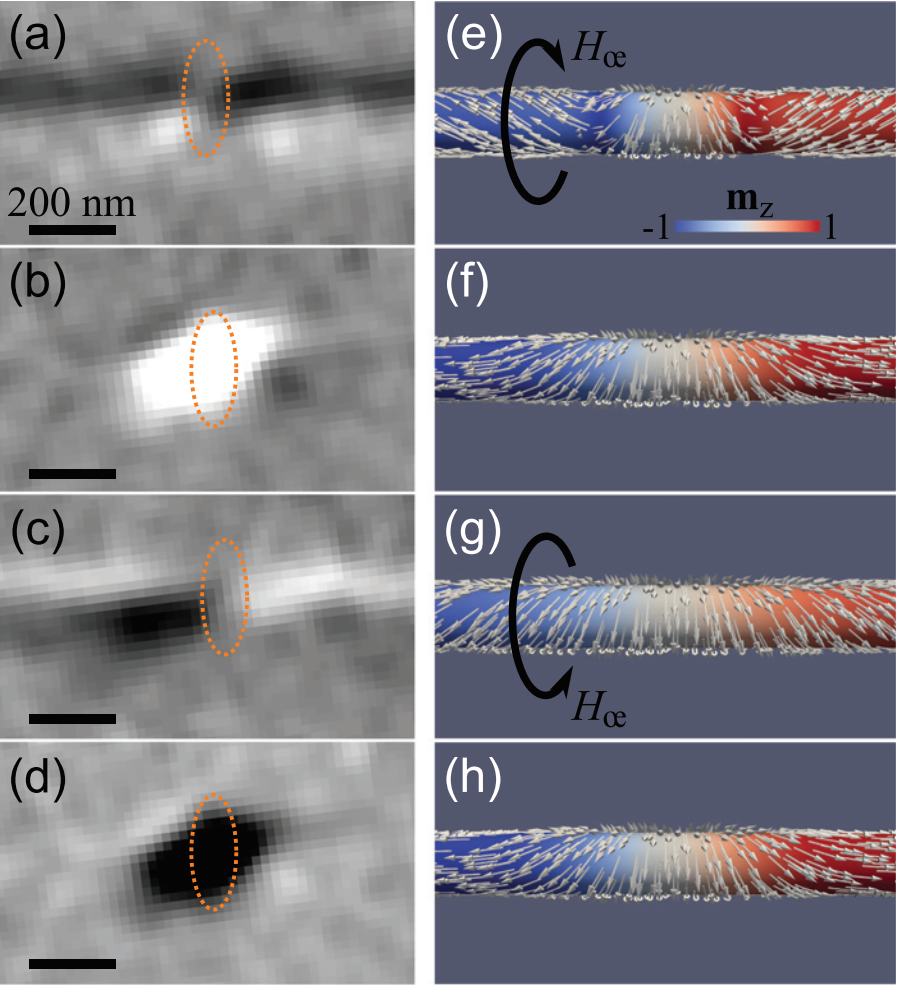We have conducted time-resolved stroboscopic imaging of the magnetization dynamics in cylindrical nanowires subject to nanosecond pulses of electric current. These confirm the dramatic impact of the Œrsted field in the cylindrical geometry. Through a thorough quantitative analysis, we extract features during the pulse of current, such as the azimuthal component of magnetization in magnetic domains and the breathing of magnetic domain walls, with an impact expected on their mobility.
Three-dimensional nanomagnetism and spintronics is a fast-rising topic, driven by the prediction of novel physical phenomena. These include curvature-induced effective magnetic anisotropy and Dzyaloshinskii-Moriya interactions, the non-reciprocal dispersion of spin waves, and specific topologies of domain walls preventing their instability compared with counterpart domain walls in thin flat strips. In recent years, we confirmed experimentally the existence of these specific domain walls in cylindrical nanowires, called Bloch-point walls, demonstrated their unusual high mobility under spin-polarized current, and hinted at the crucial role of the large Œrsted field in these three-dimensional conduits, in the stabilization of the domain walls.

Experiments (left) and simulations (right) of the impact of the OErsted field on magnetization dynamics in a 100 nm-diameter wire during nanosecond positive (a,e) and negative (c,g) current pulse, and in-between pulses (b,f and d,h).
Here, we conducted time-resolved imaging of magnetization dynamics to provide a microscopic support to our observations, inferred previously from static magnetic imaging following domain-wall motion. For that purpose, we used Scanning Transmission X-ray Microscopy (STXM) combined with X-ray Magnetic Circular Dichroism (XMCD), implemented at the Pollux beamline from the Swiss Light Source (SLS) synchrotron. We fed a periodic sequence of spin-polarized current in the wire, combining two nanosecond pulses of positive and then negative current with density >1012 A/m2, each separated by several tens of ns of waiting time. All photon bunches are collected and sorted versus their time delay by a dedicated FPGA developed at SLS, which in a few tens of minutes delivers hundreds of snapshots, each separated by only a few hundreds of picoseconds. We then developed a quantitative analysis of the images, taking into account the calibration of absorption through matter, the image broadening due to the beam size, and a background intensity resulting from incoherent illumination. Applying this to a domain wall between two tail-to-tail domains, this allowed us to put figures on the azimuthal tilt of magnetization in the otherwise axial domains, up to 30°, and the periodic breathing of the domain walls (see Figure).
These results are in excellent agreement with micromagnetic simulations, providing a firm ground for our understanding of the specific dynamics of magnetization textures in the cylindrical geometry. On this basis we are performing further experiments to control domain-wall motion in such wires, and also seek to evidence the non-reciprocity of spin waves in cylindrical magnetic nanotubes.
Teams: Spin Textures, Theory and Simulation
Collaboration: Institut Néel, Friedrich-Alexander Universität Erlangen-Nürnberg, SLS light source
Funding: Labex LANEF, ANR Matemac-3D, Renatech
Further reading: Time-resolved imaging of Œrsted field induced magnetization dynamics in cylindrical magnetic nanowires, M. Schöbitz, S. Finizio, A. De Riz, C. Thirion, D. Gusakova, J.C. Toussaint, J. Bachmann, J. Raabe, O. Fruchart, Appl. Phys. Lett. 118, 172411 (2021).
Contacts: Olivier FRUCHART, Daria GUSAKOVA




